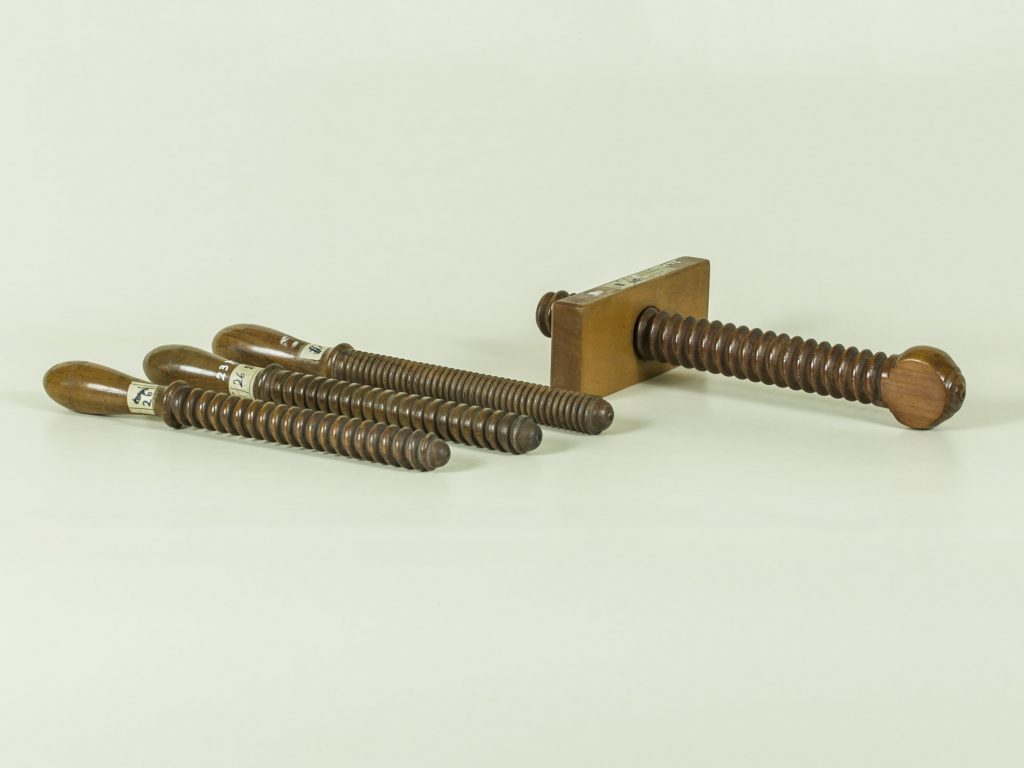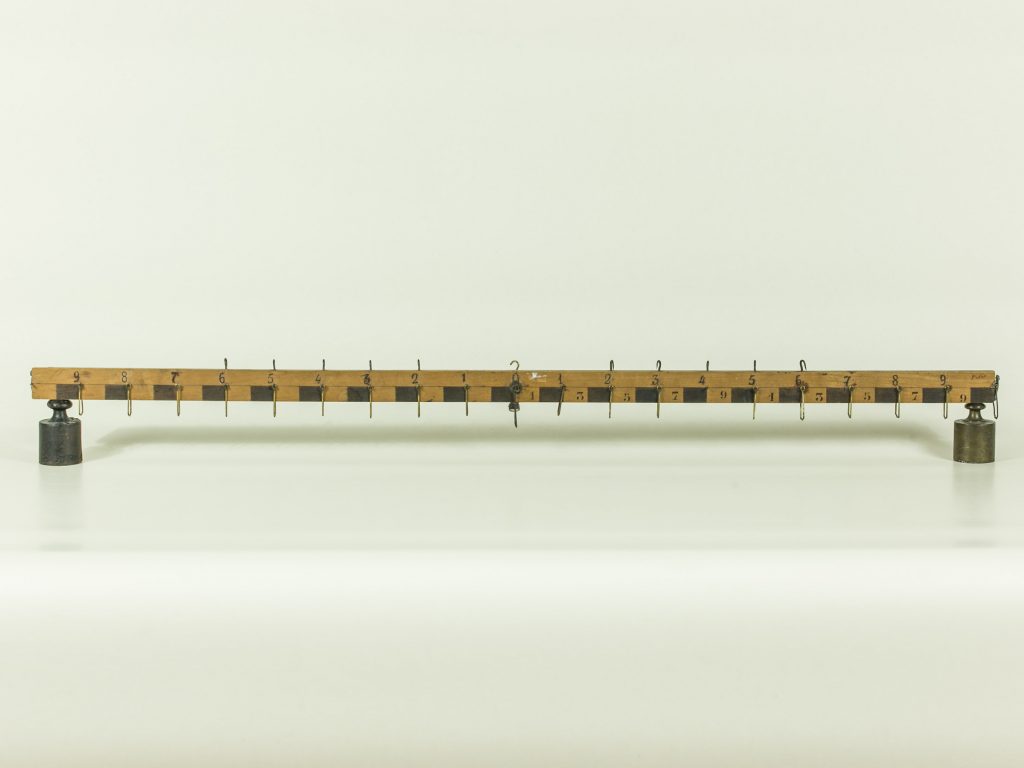08-M Apparato per la dimostrazione delle condizioni di equilibrio – Equipment for the demonstration of balance conditions
Legno, metallo, ottone
staffa: h. 420; cono 370; asta 420
1/4 XIX secolo
In un’asta di legno a forma di parallelepipedo con le estremità tornite sono fissati due perni metallici contrapposti sia lungo l’asse orizzontale passante per il baricentro, sia nel punto medio tra il baricentro e un’estremità dell’asta. In corrispondenza di tali perni, l’asta può essere fissata, per mezzo di due viti regolabili, ad un sostegno metallico a forma di staffa.
Alla stessa staffa può essere fissato un cono in legno di bosso, grazie ai perni posti lungo l’asse orizzontale passante per il baricentro.
L’apparato mostra le condizioni di equilibrio indifferente per il cono e per l’asta se sospesi lungo l’asse passante per il baricentro e le condizioni di equilibrio instabile per l’asta se sospesa per l’altro punto di sospensione.
Wood, metal, brass
stirrup: h, 420; cone 370; pole 420
¼ XIX century
Two metal pins are fixed on a wooden pole, which has a parallelepipedal shape with turned ends. The pins are opposed both on the horizontal axis, which passes through the center of gravity, and the midpoint between the center of gravity at one end of the pole. Corresponding to those pins, the pole can be fixed with two adjustable screws to a metallic support, which has the shape of a stirrup.
A boxwood cone can be fixed to the same stirrup thanks to the pins on the horizontal axis, passing through the center of gravity.
The equipment shows the stable balance condition both for the cone and the pole, if they are suspended on the axis that passes through the center of gravity, and the unstable balance conditions of the pole when it is suspended on the other suspension point.
09-M Paradosso meccanico – The mechanical paradox
Legno, metallo
560 x 290; h. 100; d. 130
4/4 XVIII secolo
Doppio cono di legno tinto in nero, con punte in ottone ai vertici, che può rotolare su due guide di legno divaricate e inclinate. Appoggiando il doppio cono sulle guide, esso si muove verso la parte più alta apparentemente risalendo lungo le guide. Si tratta forse di una contraddizione al principio che regola l’equilibrio dei corpi che spontaneamente scendono?
Il principio che regola l’equilibrio dei corpi stabilisce che ogni corpo tende spontaneamente a raggiungere la configurazione corrispondente alla minima energia potenziale, che, nella maggioranza dei casi, corrisponde ad una distanza più bassa dal suolo. Il cono tuttavia, mentre scorre lungo le guide verso l’alto, a causa della forma divaricata delle guide, appoggia nel movimento le parti più sottili cosicché il suo baricentro, la cui altezza è quella dell’asse passante per i vertici dei coni, si abbassa.
L’apparecchio è citato già nell’inventario del 1793 al numero 5 della sezione “Macchine spettanti alla meccanica”.
Riferimenti: Inventario 1793 (Biblioteca Angelo Mai, ACMM, MIA 3509), n.5.
Wood, metal
560 x 290; h. 100; d. 130
4/4 XVIII century
Double cone, made of black-stained wood, with brass tips, which is able to climb up along two spread and inclined wooden guides. When the cone is put on the runners, it moves to the top, apparently climbing up along the runners. Is it a contradiction to the principle ruling the balance of bodies that naturally go down?
The principle which rules the balance of bodies establishes that each body spontaneously reaches the configuration corresponding to the minimum potential energy, which in most cases corresponds to a lower distance to the earth. But when the cone climbs up, due to the spread shape of the guides, it places only its thinnest parts on the guides, so its center of gravity, whose height is the same as the height of the axis passing through the vertices of the cone, gets lower.
The device is mentioned in an inventory of 1793, it is the number five in the section “Devices about mechanics”
References: inventory of 1793 (Angelo Mai Library, ACMM MIA, 3509), number 5
17-M Regoli – Rulers
Legno
Cinque regoli in legno dipinto per la composizione dei moti.
Wood
Five wooden rulers painted for the composition of motions.
18-M Leva a bracci uguali su piedistallo – Equal arm lever on a pedestal
Legno, ferro
Base: 360 x 160 x 310; l. asta:1000
3/4 XIX secolo
Una base rettangolare in legno tornito sostiene un piedistallo con una staffa nella quale si inserisce una leva in legno a bracci uguali, il cui fulcro resta così fissato; la leva è di primo genere. A distanza regolare essa presenta dei gancetti in ferro ai quali possono essere sospesi pesi diversi per effettuare esperienze sull’equilibrio della leva.
La leva è stata acquistata da Allemano di Torino nel 1865.
Wood, iron
Base: 360 x 160 x 310;l. rod: 1000
A rectangular turned wooden base supports a pedestal with a bracket in which is inserted a wooden lever with equal arms, whose fulcrum remains fixed; the lever is of the first kind. At a regular distance it has iron hooks to which different weights can be suspended to carry out experiments on the balance of the lever.
The lever was bought by Allemanno from Tourin in 1865.
22-M Modello della vite – Model of the screws
Legno, pergamena
Base 80; h. 200
3/4 XIX secolo
Questo modello rappresenta il principio su cui si basa la costruzione della vite e cioè il suo rapporto con il piano inclinato.
Sul cilindro in legno di bosso lucidato ed elegantemente tornito è fissato un foglio di pergamena a forma di triangolo rettangolo, il cui cateto minore coincide con l’altezza del cilindro stesso. Avvolgendo il triangolo intorno al cilindro, l’ipotenusa – evidenziata da una riga nera – descrive il filetto della vite.
Il modello è stato acquistato dal Tecnomasio di Milano nel 1868.
Riferimenti: LPSAS, CCLXXXV, Catalogo metodico, p.17, n.26.
Wood, parchment
Base 80; h. 200
3/4 XIX century
This model represents the principle on which the construction of the screw is based and that is its relationship with the inclined plane.
On the polished and elegantly turned boxwood cylinder is fixed a sheet of parchment in the shape of a right-angled triangle, whose shorter side coincides with the height of the cylinder itself. By wrapping the triangle around the cylinder, the hypotenuse – highlighted by a black line – describes the thread of the screw.
The model was purchased by Tecnomasio of Milan in 1868.
23-M – 24M Viti di legno – Wooden screws

Legno
Viti: l. 270; madrevite: 135 x 55
3/4 XIX secolo
Tre viti in legno con impugnatura tornita e filetto diverso per uso dimostrativo (23M). Vite in legno con madrevite costituita da una tavoletta in legno (24M).
Wood
Screws: l. 270; nut: 135 x 55
3/4 XIX century
Three wooden screws with turned handle and different thread for demonstration use (23M). Wooden screw with nut made of a wooden board (24M).
26-M Ruote dentate con quadrante contagiri – Toothed wheels with a tachometer dial
Legno, ottone
Base d. 140; h. 520
2/4 XIX secolo.
Serie di otto ruote dentate con diverso raggio, montate tra due piastre d’ottone fissate in basso ad un perno, il quale è posto su un piedistallo in legno nero tornito. L’apparato illustra il funzionamento di un ingranaggio, in grado di trasmettere il movimento, ma soprattutto di amplificarlo. Le ruote sono collegate tra loro tramite pignoni e mosse da una manovella posta sulla piastra posteriore; sulla piastra opposta sono incisi tre cerchi graduati con i numeri arabi 1 – 12, sui quali può ruotare un ago mobile collegato alle ruote dentate, con funzione di contagiri. Il movimento delle ruote si ripercuote sugli indici girevoli, mostrando così la proporzionalità inversa fra il numero dei giri di ciascuna ruota e i rispettivi raggi; ad ogni giro della manovella corrispondono 1/4 di giro sul quadrante inferiore, tre giri su quello centrale e trentasei giri sul quadrante superiore collegato con la ruota più piccola.
Wood, brass
Base d. 140; h. 520
2/4 XIX century.
Series of eight toothed wheels with different radius, mounted between two brass plates fixed at the bottom to a pin, which is placed on a pedestal in black turned wood. The apparatus illustrates the functioning of a gear, able to transmit the movement, but above all to amplify it. The wheels are connected to each other by means of pinions and moved by a crank placed on the back plate; on the opposite plate are engraved three circles graduated with the Arabic numerals 1 – 12, on which can rotate a moving needle connected to the toothed wheels, with a rev counter function. The movement of the wheels affects the rotating indexes, thus showing the inverse proportionality between the number of revolutions of each wheel and the respective spokes; each turn of the crank corresponds 1/4 of turn on the lower dial, three turns on the central one and thirty-six turns on the upper quadrant connected with the smaller wheel.
38-M Leva – Lever

Legno
1000 x 420 x 10
1/4 XX secolo
Asta di legno munita di ganci e anelli ogni 5 cm, ai quali sospendere opportuni pesi per lo studio della leva.
Wood
1000 x 420 x 10
1/4 XX century
Wooden rod fitted with hooks and rings every 5 cm, from which to suspend weights for studying the lever.